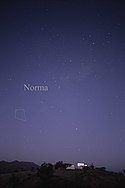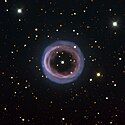Vinkelhaken
| Vinkelhaken | |
 | |
| Lista över stjärnor i Vinkelhaken | |
| Latinskt namn | Norma |
|---|---|
| Förkortning | Nor |
| Rektascension | 16[1] h |
| Deklination | -52[1]° |
| Area | 165 grad² (74) |
| Huvudstjärnor | 4 |
| Bayer/Flamsteedstjärnor | 13 |
| Stjärnor med exoplaneter | 4 |
| Stjärnor med skenbar magnitud < 3 | 0 |
| Stjärnor närmare än 50 ljusår | 0 |
| Ljusaste stjärnan | Gamma2 Normae (4,01[2]m) |
| Närmaste stjärnan | Gliese 615 (HD 145417) (44,83 lå) |
| Messierobjekt | 0 |
| Meteorregn | Gamma Normiderna |
| Närliggande stjärnbilder | Skorpionen, Vargen, Cirkelpassaren, Södra Triangeln, Altaret |
| Synlig vid latituder mellan +30° och −-90° Bäst synlig klockan 21:00 under juli. | |
Vinkelhaken (Norma på latin) är en liten stjärnbild på södra stjärnhimlen.[3][4] Konstellationen är en av de 88 moderna stjärnbilderna som erkänns av den Internationella astronomiska unionen.[5]
Historik
Vinkelhaken har omväxlande kallats Triangulum Australe och Quadrans Euclidis (Euklides vinkelhake) innan den fick en ordentlig beskrivning av den franske astronomen Nicolas Louis de Lacaille 1751 och tillhör stjärnhimlens verktyg. Först fick den namnet l’Equerre et la Regle, eftersom Lacaille tänkte på ritarens vinkelhake och linjal. För att få en ordentlig stjärnbild lånade Lacaille två stjärnor från den angränsande stjärnbilden Skorpionen, som fick namnen Alfa och Beta Normae. Dessa har senare lämnats tillbaka till Skorpionen, varför Vinkelhakens ljusstarkaste stjärna numera heter Gamma Normae.
Stjärnor

Vinkelhaken är en stjärnbild utan ljusstarka stjärnor. Stjärnorna Gamma1 Nor, Gamma2 Nor bildar tillsammans med Epsilon och Eta Nor en rätvinklig triangel bland en mängd svagare stjärnor i bakgrunden.[5]
- γ - Gamma Normae är en dubbelstjärna som är ljusstarkast i stjärnbilden med magnitud 4,01. Den består av en gul jättestjärna, som själv är dubbelstjärna, och en gulvit superjätte av spektralklass F9Ia.[2]
- ε - Epsilon Normae är en dubbelstjärna av magnitud 4,53 och spektralklass B4V.
- R Normae är en Miravariabel som varierar i ljusstyrka 6,5 – 13,9 med en period av 507,5 dygn.
- S Normae (47 Normae) är en Cepheid-variabel som varierar i ljusstyrka 6,12 – 6,77 med perioden 9,75411 dygn. S Normae befinner sig i centrum av stjärnhopen NGC 6087, S Normae-hopen.
Djuprymdsobjekt


Stjärnbilden innehåller inga Messierobjekt med många andra intressanta objekt på grund av dess läge i Vintergatan.[6][5]
Stjärnhopar
- NGC 6025 och NGC 6031 är öppna stjärnhopar.
- NGC 6067 är en öppen stjärnhop i närheten av Kappa Normae, med magnituden 5,6.
- NGC 6087 (S Normae-hopen eller Caldwell 89) är också en öppen stjärnhop, av magnitud 5,4.
- NGC 6152 och NGC 6167 är öppna stjärnhopar.
Galaxhopar
- Norma-hopen – Abell 3627 är en galaxhop ungefär 221,1 miljoner ljusår från jorden. Galaxhopen är svår att observera eftersom den är förmörkad av stoft och ligger i en region som skyms av Vintergatan. Den befinner sig i närheten av den Stora attraktorn.
Nebulosor
- Shapley 1, är en planetarisk nebulosa av magnitud 12,6. Centralstjärnan är en vit dvärg av magnitud 14. Nebulosan upptäcktes 1936 av den amerikanske astronomen Harlow Shapley.
- Menzel 1 är en planetarisk nebula av magnitud 12,0. Den beräknas vara mellan 4500 och 10000 år gammal.
- Menzel 3 är också en planetarisk nebulosa i Vinkelhaken.
Referenser
- ^ [a b] ”Norma, constellation boundary”. The Constellations. International Astronomical Union. http://www.iau.org/public/themes/constellations/#nor. Läst 23 maj 2015.
- ^ [a b] ”Basic data: * gam Nor –Double or multiple star”. Centre de Données astronomiques de Strasbourg. http://simbad.u-strasbg.fr/simbad/sim-basic?Ident=Gamma+Normae&submit=SIMBAD+search. Läst 23 maj 2015.
- ^ Ian Ridpath och Wil Tirion (2007). Stars and Planets Guide. Princeton University Press, Princeton. ISBN 978-0-00-725120-9
- ^ ”De nutida stjärnbilderna”. Naturhistoriska Riksmuseet. http://www.nrm.se/faktaomnaturenochrymden/rymden/denutidastjarnbilderna.2277.html. Läst 23 maj 2015.
- ^ [a b c] ”Norma Constellation”. http://www.constellation-guide.com/constellation-list/Norma-constellation/. Läst 23 maj 2015.
- ^ Astronomica – Galaxer – planeter – stjärnor – stjärnbilder – rymdforskning. Tandem Verlag GmbH (svensk utgåva). 2007. sid. 414-415. ISBN 978-3-8331-4371-7
Externa länkar
 Wikimedia Commons har media som rör Vinkelhaken.
Wikimedia Commons har media som rör Vinkelhaken.
| ||||||||||||||||
Media som används på denna webbplats
Författare/Upphovsman: IAU and Sky & Telescope magazine (Roger Sinnott & Rick Fienberg), Licens: CC BY 3.0
IAU Norma chart
The Ant planetary nebula (Menzel 3 or Mz 3). STScI-PRC2001-05
This NASA/ESA Hubble Space Telescope image reveals the ant's body as a pair of fiery lobes protruding from a dying, Sun-like star. Though approaching the violence of an explosion, the ejection of gas from the dying star at the center of Mz3 has intriguing symmetrical patterns unlike the chaotic patterns expected from an ordinary explosion. Scientists using the Hubble space telescope would like to understand how a spherical star can produce such prominent, non-spherical symmetries in the gas that it ejects.
One possibility is that the central star of Mz3 has a closely orbiting companion that exerts strong gravitational tidal forces, which shape the outflowing gas. For this to work, the orbiting companion star would have to be close to the dying star, about the distance of the Earth from the Sun. At that distance the orbiting companion star wouldn't be far outside the hugely bloated hulk of the dying star. It's even possible that the dying star has consumed its companion, which now orbits inside of it, much like the duck in the wolf's belly in the story "Peter and the Wolf."
A second possibility is that, as the dying star spins, its strong magnetic fields are wound up into complex shapes. Charged winds moving at speeds up to 1000 kilometers per second from the star, are able to follow the twisted field lines on their way out into space. These dense winds can be rendered visible by ultraviolet light from the hot central star or from highly supersonic collisions with the ambient gas that excites the material into florescence.
Astronomers Bruce Balick (University of Washington) and Vincent Icke (Leiden University) used Hubble to observe this planetary nebula, Mz3, in July 1997 with the Wide Field Planetary 2 camera. One year later, astronomers Raghvendra Sahai and John Trauger of the Jet Propulsion Lab in California snapped pictures of Mz3 using slightly different filters. This intriguing image, which is a composite of several filters from each of the two datasets, was created by the Hubble Heritage Team.Författare/Upphovsman: Till Credner, Licens: CC BY-SA 3.0
Photography of the constellation Norma, the square
Författare/Upphovsman: ESO, Licens: CC BY 3.0
The hazy and aptly named Fine Ring Nebula, shown here, is an unusual planetary nebula. Planetary nebulae form when some dying stars, having expanded into a red giant phase, expel a shell of gas as they evolve into white dwarfs. Most planetary nebulae are either spherical or elliptical in shape, or bipolar (featuring two symmetric lobes of material).
But the Fine Ring Nebula — captured here by the ESO Faint Object Spectrograph and Camera mounted on the New Technology Telescope at the La Silla Observatory in Chile — looks like an almost perfect circular ring. Astronomers believe that some of these more unusually shaped planetary nebulae are formed when the progenitor star is actually a binary system. The interaction between the primary star and its orbiting companion shapes the ejected material.
The stellar object at the centre of the Fine Ring Nebula is indeed thought to be a binary system, orbiting with a period of 2.9 days. Observations suggest that the binary pair is almost perfectly face-on from our vantage point, implying that the planetary nebula’s structure is aligned in the same way. We are looking down on a torus (doughnut shape) of ejected material, leading to the strikingly circular ring shape in the image.
Planetary nebulae are shaped by the complex interplay of many physical processes. Not only can these celestial objects be admired for their beauty, but the study of precisely how they form their striking shapes is a fascinating topic in astronomical research.
This image was made using multiple filters: light observed through B and O-III filters is shown in blue, V is shown in green, R is shown in orange, and H-alpha in red. The image is approximately 200 arcseconds across.




